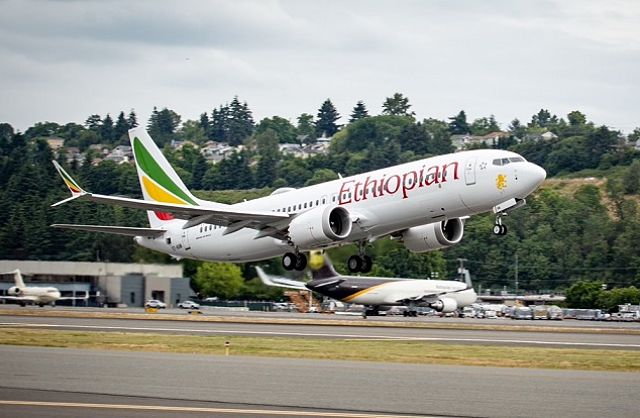 Boeing knew about 737 Max safety problems two years before the deadly Ethiopia and Indonesia crashes, according to a statement released by the company this week. (Photo: Ethiopian Airlines 737 Max aircraft/Boeing)
Boeing knew about 737 Max safety problems two years before the deadly Ethiopia and Indonesia crashes, according to a statement released by the company this week. (Photo: Ethiopian Airlines 737 Max aircraft/Boeing)
Tadias Magazine
By Tadias Staff
Published: May 8th, 2019
New York (TADIAS) – Boeing was aware of the software problem with its 737 Max aircraft as far back as 2017, long before the tragic crash of Ethiopian Airlines Flight 302 on March 10th of this year that killed all 157 on board as well as the prior Indonesian Lion Air accident that took the lives of 189 passengers.
Boeing made the stunning admission in a press release this past weekend noting that it discovered a software related issue with the 737 Max two years ago, but it deemed the now globally grounded airplane safe after an internal examination.
“In 2017, within several months after beginning 737 MAX deliveries, engineers at Boeing identified that the 737 MAX display system software did not correctly meet the AOA Disagree alert requirements,” the statement said. “When the discrepancy between the requirements and the software was identified, Boeing followed its standard process for determining the appropriate resolution of such issues.” The press release added: “That review, which involved multiple company subject matter experts, determined that the absence of the AOA Disagree alert did not adversely impact airplane safety or operation. Accordingly, the review concluded, the existing functionality was acceptable until the alert and the indicator could be delinked in the next planned display system software update. Senior company leadership was not involved in the review and first became aware of this issue in the aftermath of the Lion Air accident.”
In the case of the Ethiopia crash, investigators have preliminarily ruled that a malfunctioning software flight data sensor was to blame for the accident and that the pilots performed all the procedures recommended by Boeing but could not control the plane.
The Boing revelation also comes on the heels of a recent Times article entitled “Shoddy Production Draw Scrutiny to a Second Boeing Jet” listing complaints of poor-quality manufacturing at one of its plants that raises more questions about Boeing’s overall credibility on the matter.
“Boeing is issuing a display system software update, to implement the AOA Disagree alert as a standard, standalone feature before the MAX returns to service,” the press release added.
But a recently released study shows that the public is skeptical. “In a survey of 1,765 fliers conducted by Barclays Investment Bank, 44 percent of respondents said they would wait a year or more before flying the 737 Max, compared with 39 percent who said they would do so within a few months of its reentry into service,” The Washington Post reported yesterday. “Only 20 percent said they would fly on a Max as soon as the grounding order is lifted, and 52 percent said they would rather fly on another type of aircraft.”
—
Related:
Read Excerpt From Ethiopia Crash Report
Watch: Ethiopia Releases 737 Max Preliminary Crash Report
Ethiopian Airlines Expresses Disappointment – Calls Out Media Outlets Eager to Blame Pilot
Join the conversation on Twitter and Facebook.

























